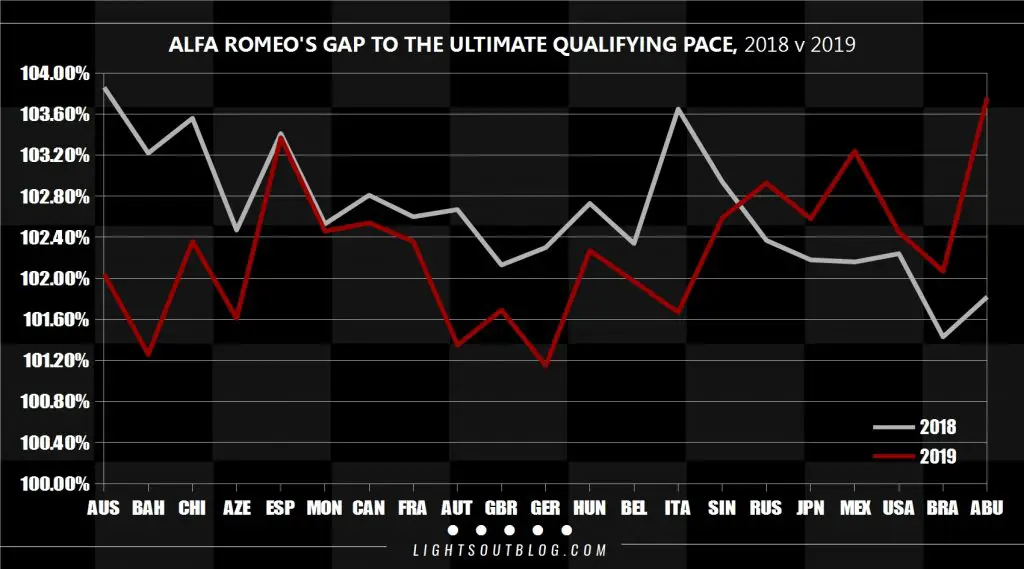The Alfa Romeo name returned to the grid in 2019, and the new name took up where Sauber left off. Here are all the facts and statistics from Alfa Romeo’s season.

The Sauber name disappeared from the F1 grid for the 2019 season. The team re-branded as Alfa Romeo, marking a return of the famous Italian marque to the sport since 1985. Although they had a new name, and a new driver line-up in the form of Kimi Raikkonen and Antonio Giovinazzi, the team remained in their familiar midfield position.
Raikkonen provided the expected consistent results, while rookie Giovinazzi’s form improved over the course of the year. Austria and Brazil were the only rounds of the championship where both drivers finished in the top ten.
In some ways Alfa Romeo continued Sauber’s upward trend of 2018, scoring more points than they had in the previous season and recording more Q3 appearances this year than in 2018. Alfa Romeo recorded the team’s best result since 2013. That year, Sauber also scored 57 points, but finished one position further up in the Constructors’ Championship. Will the team be able to keep up with other outfits such as McLaren, Renault, Racing Point and Toro Rosso in 2020?
[one_half]
RACE STATISTICS
- Championship Position: 8th
- Total Points: 57
- Points Scoring Races: 11
- Double Points Finishes: 2
- Best finish: 4th (Brazil)
- Number of DNFs: 4
- Laps Led: 4
- Laps Complete: 2435 (2nd)
- % of Laps Complete: 96.47%
- Distance Covered: 12294.382km
[/one_half][one_half_last]
QUALIFYING STATISTICS
- Both cars in Q3: 2
- Q3 Appearances: 12
- Q2 Exits: 21
- Q1 Exits: 9
- Best Qualifying Position: 5th
- Worst Qualifying Position: 19th
- Average Gap to Ultimate Pace: 2.04%
[/one_half_last]
A STATISTIC FROM EVERY GRAND PRIX
Australia: At the 2019 Australian Grand Prix, the Alfa Romeo name returned to the Formula 1 grid for the first time since the 1985 Australian Grand Prix. With Kimi Raikkonen reaching Q3, this was the former Sauber team’s first appearance in Q3 at the Australian Grand Prix since 2011. With Antonio Giovinazzi reaching Q2, it was also the first time neither of the team’s drivers was eliminated in Q1 here since 2012. In the race, Raikkonen scored the team’s first points at the track since 2015, while Giovinazzi ensured both of the team’s cars finished the event for the first time since 2015.
Bahrain: With Kimi Raikkonen qualifying in ninth at the 2019 Bahrain Grand Prix, the former Sauber team recorded their first top ten appearance in qualifying in Bahrain since the 2012 season.
China: Both of Alfa Romeo’s drivers recorded their worst Chinese Grand Prix qualifying positions in 2019, while the Alfa Romeo team continued their record of not reaching Q3 at the Chinese Grand Prix since 2015.
Azerbaijan: For the first time in the 2019 season, both Alfa Romeo drivers reached the final part of qualifying at the Azerbaijan Grand Prix. It was the first time the team have appeared in Q3 at the Baku City Circuit.
Spain: After the 2019 event, the Alfa Romeo team have now failed to get a car into the top ten in qualifying at the Spanish Grand Prix in all of the last seven years.
Monaco: In qualifying for the 2019 Monaco Grand Prix, both of the former Sauber team’s cars were eliminated in Q2. It’s the first time that has happened at this circuit since 2010. Both of the team’s drivers reached the end of the race for the first time since 2015.
Canada: For the sixth time in the last seven seasons, the former Sauber team left the Canadian Grand Prix without picking up any points. In qualifying, neither of their cars reached Q3 for the tenth consecutive season.
France: Kimi Raikkonen finished seventh in the 2019 French Grand Prix, scoring Alfa Romeo’s best ever finish at Circuit Paul Ricard. Their previous best result was ninth place for Bruno Giacomelli in 1982.
Austria: Alfa Romeo recorded the same result at the Austrian Grand Prix in 2019 as Sauber did in 2018, with their drivers finishing ninth and tenth. It was the first time both of their cars have scored in the same race since the 2018 Mexican Grand Prix. Before the 2019 weekend, the team had only appeared in Q3 once before at the track, with Felipe Nasr in 2015. In 2019, both Kimi Raikkonen and Antonio Giovinazzi reached the top ten.
Britain: Kimi Raikkonen picked up the former Sauber team’s first points at the British Grand Prix since Nico Hulkenberg finished tenth in 2013. Forgetting the team’s Sauber heritage, this is the first time an Alfa Romeo driver has scored points at Silverstone since 1951, when all three of the team’s drivers finished in the top six.
Germany: Before picking up post-race penalties, Alfa Romeo were having a great weekend at the 2019 German Grand Prix and were set for a double points finish. On Saturday, Kimi Raikkonen recorded his best qualifying result since leaving Ferrari with fifth on the grid. It was the first time an Alfa Romeo driver has qualified in the top five since Eddie Cheever lined up fourth on the grid at the 1985 Monaco Grand Prix and the first time a driver for the former Sauber team has qualified in the top five since Nico Hulkenberg qualified fourth at the 2013 United States Grand Prix.
Hungary: At the 2019 Hungarian Grand Prix, Kimi Raikkonen became the former Sauber team’s first driver to appear in Q3 at the Hungaroring since Sergio Perez in 2011.
Belgium: In 2019, for the seventh time in the last nine seasons, the former Sauber team failed to score at the Belgian Grand Prix. With Antonio Giovinazzi crashing out, this was the fourth consecutive season that the team have recorded a DNF at the circuit.
Italy: With Antonio Giovinazzi finishing in ninth place at the 2019 Italian Grand Prix, the former Sauber team scored their first points at Monza since 2015. It was the first time Alfa Romeo have scored at the circuit since 1984, when Riccardo Patrese finished in third place.
Singapore: With Antonio Giovinazzi leading four laps of the 2019 Singapore Grand Prix, Alfa Romeo became the first team other than Mercedes, Ferrari or Red Bull to lead a lap of an F1 race since Williams led the opening laps of the 2015 British Grand Prix. For the team, it was the first time the former Sauber cars have led a race since Esteban Gutierrez led two laps of the 2013 Spanish Grand Prix, and the first time the Alfa Romeo name has led a race since Andrea de Cesaris led the 1983 Belgian Grand Prix.
Russia: For the fourth time in six Russian Grands Prix, the former Sauber team failed to score at the Sochi Autodrom since 2014.
Japan: In 2019, the former Sauber team continued their streak of being unable to reach Q3 and unable to score at the Japanese Grand Prix in every season since 2013.
Mexico: After scoring with both cars and reaching Q3 with both cars at the 2018 Mexico Grand Prix, Alfa Romeo returned to their form of failing to reach Q3 or score at the Autodromo Hermanos Rodriguez in 2019 – just as they had done in 2015, 2016 and 2017.
United States: Both Alfa Romeo drivers were eliminated in Q1 for the 2019 United States Grand Prix, marking the first time the team have suffered a double Q1 elimination since the 2018 Italian Grand Prix
Brazil: Kimi Raikkonen and Antonio Giovinazzi finished fourth and fifth in the 2019 Brazilian Grand Prix. It was the first time Alfa Romeo have had two drivers finish in the top five since the 1951 Spanish Grand Prix – when Juan Manuel Fangio, Giuseppe Farina and Felice Bonetto finished first, third and fifth. It was the first time the former Sauber team have finished with both cars in the top five since Robert Kubica and Nick Heidfeld finished fourth and fifth in the 2009 Belgian Grand Prix, and the first time both of their cars have finished in the points in Brazil since 2007.
Abu Dhabi: Alfa Romeo recorded their second double Q1 elimination of the 2019 season at the season-closing Abu Dhabi Grand Prix. It was the team’s third double Q1 exit at the track in the last four seasons.




